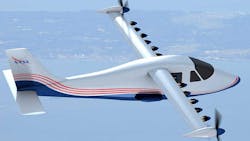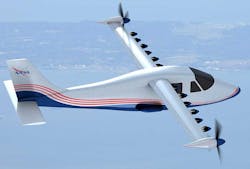Charting the Course to Electric Aircraft
This article appeared in Machine Design and has been published here with permission.
Improvements in lithium batteries, combined with a push toward cutting back on the use of petroleum- and oil-based aviation fuels, are leading aerospace engineers to explore the possibilities of electric motors and batteries for powering aircraft of all sizes—from general aviation to long-range cargo and passenger transporters. Electric propulsion is said to offer several benefits, including lower fuel and maintenance costs, less noise and air pollution, and opportunities for new, innovative aircraft designs.
But how will aerospace and airline companies manage to make electric aircraft economical and durable? To get an idea of what is needed to make this happen, the DOE’s Vehicle Technologies Office and NASA’s Glenn Research Center convened a conference at the Argonne Collaborative Center for Energy Storage Science.
The two-day event drew nearly 100 experts from aircraft, battery, and materials companies; component makers; carmakers; and academic and national lab researchers. At the end of the conference, they generated an outline of the battery requirements and R&D needed to accelerate commercialization of electric propulsion, going from air taxis in the near-term to 737 class aircraft in the long-term.
The paper explores four aircraft concepts: air taxis, 20-passenger commuter aircraft, 50-passenger regional jets, and 150-passenger, single-aisle 737-class aircraft. For each concept, the paper describes a research area in which DOE and NASA could spur innovation in electric aviation batteries.
Air taxi and commuter aircraft. NASA/DOE should evaluate the next generation of lithium-ion battery options such as silicon, advanced cathodes and lithium-metal. Test should be done under aviation conditions and examine failure modes and safety.
Regional jets. NASA/DOE should conduct R&D into new designs, manufacturing approaches and high-temperature operation for solid-state batteries.
737 class aircraft. NASA/DOE should study high-energy systems, including sulfur-based batteries and hydrogen carriers, that are far beyond those currently in the R&D pipeline.
Significant investments are already being made in the next era of aviation by aerospace companies, including Boeing, Airbus, Rolls, GE, United Technologies, Embraer, and Bell. In addition, numerous startups in the U.S. are based on innovations for aviation. This includes Uber Elevate, which aims to provide affordable shared flights on mostly electric aircraft by 2023. It also includes auto companies such as Daimler, Toyota, Hyundai, and Porsche that are getting involved in aviation startups. In fact, Hyundai is in partnership with Uber on a concept airplane with a 60-mile range.
In the near-term, engineers could adapt lithium-ion batteries to meet the needs of short-range aircraft concepts for initial market introduction. More electric aircraft will then be developed as the market expands. However, electrification of large regional and 737-class aircraft will be stalled until a new type of energy storage is developed and proven. So, the next decade will see a global race to commercialize electric flight, according to the white paper.
About the Author
Stephen Mraz
Senior Editor
Steve serves as Senior Editor of Machine Design. He has 23 years of service and has a B.S. Biomedical Engineering from Steve was a Flight officer in the U.S. Navy. He is currently responsible for areas such as aerospace and medical.

